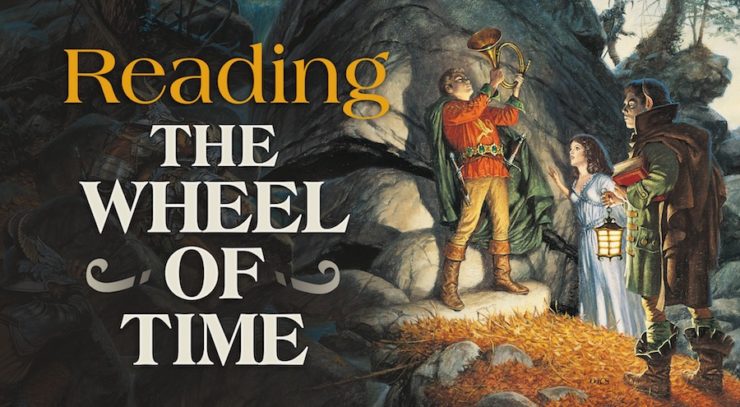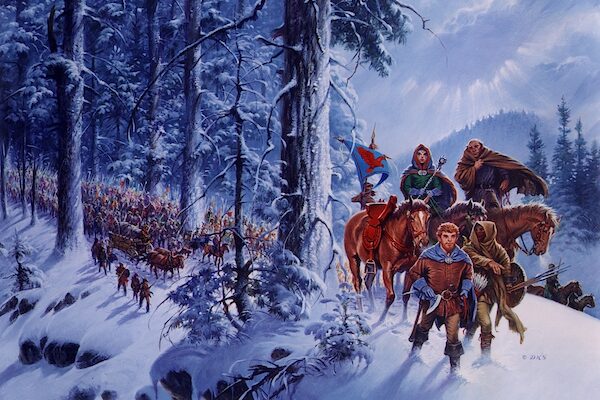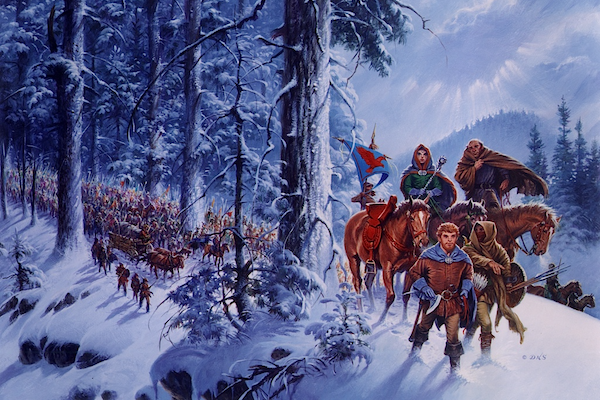It seems to be a standard of epic fantasy that all the important characters have a ton of names. I mean, it’s Aragorn’s fault, right? The guy spent so many years traveling incognito, and he picked up all those names along the way, plus there are his elvish names and the names that relate to his heritage! Elessar, Estel, Longshanks, Strider, Thorongil, Wingfoot, Envinyatar… and I’m sure I’m missing some. Now that’s set up as a standard, and we get al’Lan Mandragoran, Lord of the Seven Towers, Lord of the Lakes, Dai Shan, uncrowned King of Malkier, and Rand al’Thor, who’s the Dragon Reborn on his own merit even before he inherits Lews Therin Telamon’s titles, like Lord of the Morning. I guess being reincarnated throws a unique twist in this game of many names.
It can sometimes be difficult to keep track of who’s who when everyone has a plethora of names and titles and lives, and that’s before they’re adopting disguises and calling themselves “Selene” or “Bors.” But of all the tricky name business in the first two books of Robert Jordan’s The Wheel of Time, the man who calls himself Ba’alzamon might have claim to the most intricate of all. And he certainly has claim to the one that pulled the wool over my eyes the most.
When we meet Ba’alzamon in Rand’s dreams, we understand him to be the Dark One himself. Everyone knows Ba’alzamon is a Trolloc name for the Dark One, after all—it’s not his true name, but then it is not safe for even his followers to speak that name aloud. No one questions that Rand is indeed seeing the Dark one in his dreams, and many are alarmed that the seal on the Dark One’s prison is weakening so much as to allow him this reach. When she first learns of their dreams in The Eye of the World, Moiraine theorizes that Rand, Mat, and Perrin’s status as ta’veren makes them stand out in the Pattern, a theory that Ba’alzamon later confirms when talking to Rand in The Great Hunt, but she doesn’t look for an explanation that would accommodate Ba’alzamon still being completely trapped. I offer one to you now: Ba’alzamon is not actually a name for the Dark One, but rather a name used for the most powerful of the Forsaken, Ishamael, the Betrayer of Hope.
Buy the Book
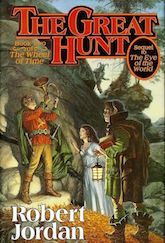

The Great Hunt
We are first introduced to the “Betrayer of Hope” right in the Prologue of The Eye of the World, in which his original name (in that lifetime, anyway) is given as Elan Morin Tedronai. This name never comes up again in either The Eye of the World or The Great Hunt, but the title is later tied to the member of the Forsaken called Ishamael by Moiraine in Chapter 42 of The Eye of the World. Presumably, then, Ishamael means “Betrayer of Hope” in the Old Tongue.
But who is Ishamael and how could he be the true face behind the being that has been calling himself “Ba’alzamon?” It’s hard for me to believe that the Dark One would be okay with anyone, even one of his own followers, pretending to be him, but there may be a plan that requires it, and I can certainly see how, if the Dark One could pass one of his human followers off as himself, this would enhance the fear and uncertainty among the ranks of his enemies.
The first usage in The Eye of the World of the name Ba’alzamon is when Moiraine is telling the story of Manetheren to the people of Emond’s Field.
…dawn revealed the banner of Ba’alzamon at their head. Ba’alzamon, Heart of the Dark. An ancient name for the Father of Lies. The Dark One could not have been free of his prison at Shayol Ghul, for if he had been, not all the forces of humankind together could have stood against him, but there was power there. Dreadlords, and some evil that made that light-destroying banner seem no more than right and sent a chill into the souls of the men who faced it. (TEOTW, p. 139)
Moiraine has said more than once that if the Dark One was actually freed from his prison, all of humankind could not stand against him, and this assertion is repeated a few other times in the book, both by her and by others, such as when Lord Agelmar’s hears that Fain claims to have met “a man who named himself Ba’alzamon” at Shayol Ghul.
Agelmar shook his head contemptuously. “The Dark One? Pah! The man’s lying or mad. If Heartsbane were loose, we’d all of us be dead by now, or worse.” (TEOTW, p. 660)
The threat of the Dark One breaking free is the endgame in the series; it is prophesied to eventually happen at the moment of the Last Battle, when the Dragon will face him with the Horn of Valere. Ba’alzamon’s presence in Rand and Mat and Perrin’s dreams throws confusion on the status of the Dark One’s imprisonment. Moiraine even questions if the seal on his prison has grown so weak that he can reach forth and touch the Pattern, directing the course of events, and this concern bears out when Ba’alzamon claims, during his confrontation with Rand at the end of The Eye of the World, to have orchestrated everything that led Rand to that moment. So we can see that, unsurprisingly, it is useful to the forces of the Dark One to make their enemies believe that he has more power and influence than he actually does at this moment in time. Fear is one of Shai’tan’s greatest weapons, after all. And Jordan left us clues in the narrative to discover that this Ba’alzamon may not be entirely what he seems to be.
One of the biggest tip-offs here is actually not in the text of The Eye of the World or The Great Hunt, but rather in the glossaries of each.
Ba’alzamon (bah-AHL-zah-mon): In the Trolloc tongue, “Heart of the Dark.” Believed to be the Trolloc name for the Dark One.
This “Believed to be” is significant. Both Moiraine and others have said flat-out that Ba’alzamon is the Trolloc name for the Dark One, and there is no suggestion within the actual text to suggest that this knowledge is in any way uncertain. But there is no reason to say that Ba’alzamon is “believed to be” a name for the Dark One unless there is doubt. With this in mind, I went back and looked at the conversations the person calling himself Ba’alzamon has with Rand, and I noticed that he never claims any of the Dark One’s other titles, never actually refers to himself as Shai’tan or the Lord of the Dark, although he does drop those names in a more general sense.
For example, when Ba’alzamon returns to Rand’s dreams for the first time in The Great Hunt, he references Shai’tan by name but does not directly apply that name to himself. When the true name of the Dark One is uttered, the darkness behind Ba’alzamon reacts, growing and thickening, and when Rand denies him, settles back again. Rand, along with Mat and Perrin, were denying the Dark One in their dreams all the time back in The Eye of the World—Moiraine specifically told them that if they deny him, his power fails—but this is the only instance in which we’ve actually seen any kind of reaction to that denial. It’s almost as if the Dark One wasn’t there in those dreams at all, and only now is his presence beginning to show, as an impenetrable mass of darkness hovering behind his agent.
There are other clues to suggest that Ba’alzamon might not actually be the Dark One. In the Prologue of The Great Hunt, the man who called himself Bors is shocked that the Dark One would appear to them in the form of a man. He is puzzled also by the mask, and by the burns on his hands. Bors is a powerful enough Darkfriend to be summoned to this gathering and given a special task, so one expects that he has some knowledge of what he’s talking about. Bors even wonders if this might not be the Dark One at all, but one of the Forsaken, which he finds almost as terrifying a prospect. This shows how much beyond typical Darkfriend status the Forsaken really are, and suggests that the terror that Ba’alzamon inspires is of a level that one of the Forsaken might be able to muster.
Although the Forsaken and their imprisonment is mentioned a few times in The Eye of the World, it took me a while to figure out how they got there, since it is usually mentioned lumped in with the Dark One, as though both were bound by the Creator. But that isn’t the whole story. The Dark One was bound by the Creator, the Forsaken were sealed in there with him after they tried to break into his prison to free him, and Lews Therin and his followers stopped them. Ishamael is named several times as one of the Forsaken, but when Aginor explains how he and Balthamel were freed from imprisonment because they were the closest to the surface, he makes an interesting comment.
“[We were] bound.” Aginor smiled; his yellowed teeth had the look of fangs. “Some of us are bound no longer. The seals weaken, Aes Sedai. Like Ishamael, we walk the world again, and soon the rest of us will come. (TEOTW, p. 690)
It didn’t occur to me on the first read to analyze those words too closely, but Aginor actually tells us everything we need to know here. Ishamael is walking the world. Indeed, Aginor says “we walk the world” like him, not “we have been freed” like him—there is nothing to say he was even imprisoned to begin with.
Which, in fact, he was not.
The events of the Prologue of The Eye of the World take place after the final confrontation and the resealing of the Dark One’s prison. Lews Therin has already been taken by the taint, but Elan Morin is there to restore his faculties, to taunt him over what has been done. This shows that he was never imprisoned as the others were; somehow he escaped that fate, and has been free in the world since then, no doubt able to orchestrate much mischief. Then, when Rand confronts Ba’alzamon in his dream while at the Stag and Lion, he repeats the creed that the Dark One and all the Forsaken are bound in Shayol Ghul, and Ba’alzamon responds with anger.
“Fool, I have never been bound!” The fires of his face roared so hot that Rand stepped back, sheltering behind his hands. The sweat on his palms dried from the heat. “I stood at Lews Therin Kinslayer’s shoulder when he did the deed that named him. It was I who told him to kill his wife, and his children, and all his blood, and every living person who loved him or whom he loved. It was I who gave him the moment of sanity to know what he had done. Have you ever heard a man scream his soul away, worm? He could have struck at me, then. He could not have won, but he could have tried. Instead he called down his precious One Power upon himself, so much that the earth split open and reared up Dragonmount to mark his tomb. (TEOTW, p. 203)
At the time, I took this as a poetic speech. Believing Ba’alzamon to be the Dark One, I assumed that he meant that, despite being imprisoned, he is not “bound” because he has had the ability to reach out to touch men’s souls, to influence them and their world. He stood figuratively at Lews Therin’s shoulder because it was the Dark One’s taint that caused it. He gave Lews Therin his momentary glimpse of sanity because it was through Shai’tan’s power that the healing was done. But looking at it now, I see that it can be read literally. Elan Morin, also known as Ishamael, the Betrayer of Hope, was actually there. It’s much more simple than I took it all to be.
Buy the Book
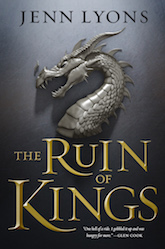

The Ruin of Kings
Ba’alzamon goes on to talk about other events he influenced, including stoking Artur Hawkwing’s hatred of the Aes Sedai and getting him to send some of his armies across the ocean. Back in Chapter 8, as she prepares to heal Tam, Moraine mentions that ever since “the wars that ended the Age of Legends, since the Forsaken were bound, [Myrddraal] have been the brain that tells the Trolloc fists where to strike.” (TEOTW p. 117) Knowing what we know now, this is probably not true. Ishamael has been the brain behind everything, and he has not even had any other of the Forsaken around to challenge him for power or control. It has been the Ishamael show all this time, and that speaks, I think, to the grand way he talks about himself. At this point , he probably thinks of himself as almost as great as the Dark One.
There is a great example of Ba’alzamon’s careful wordplay in his encounter with Rand in the mist, while in the mirror world. It shows how he invokes the name of the Dark One without actually claiming to be him.
“I have a thousand strings tied to you, Kinslayer, each one finer than silk and stronger than steel. Time has tied a thousand cords between us. The battle we two have fought—do you remember any part of that? Do you have any glimmering that we have fought before, battles without number back to the beginning of Time? I know much that you do not! That battle will soon end. The Last Battle is coming. The last, Lews Therin. Do you really think you can avoid it? You poor, shivering worm. You will serve me or die! And this time the cycle will not begin anew with your death. The grave belongs to the Great Lord of the Dark. This time if you die, you will be destroyed utterly. This time the Wheel will be broken whatever you do, and the world remade to a new mold. Serve me! Serve Shai’tan, or be destroyed forever!” (TGH, p. 241)
It sounds like Ba’alzamon is just naming himself in the third person there, but he’s actually commanding Rand first to serve him, Ba’alzamon/Ishamael, and then to serve Shai’tan. It’s really clever, and the whole thing is backed up by the fact that Ishamael definitely does view himself and Lews Therin as two sides of a coin, as he mentioned earlier in the same conversation. What threw me for a while was this insistence that he and Rand have faced each other throughout time; the legends and beliefs about the Dragon say that he is a foil to the Dark One, and makes no mention of there being a sort of “Dark Dragon” to Rand’s Light. It would make sense if there was one, a human who serves as the Dark One’s hand and a human who serves as the Creator’s, but you would think that there would be some knowledge of such a relationship outside of what Ishamael has said. But whether or not Ishamael’s read on their relationship is accurate and unbiased, the fact remains that we saw the same claim from Elan Morin.
“Ten years! You pitiful fool! This war has not lasted ten years, but since the beginning of time. You and I have fought a thousand battles with the turning of the Wheel, a thousand times a thousand, and we will fight until time dies and the Shadow is triumphant!” He finished in a shout, with a raised fist, and it was Lews Therin’s turn to pull back, breath catching at the glow in the Betrayer’s eyes. (TEOTW, p. 14)
When Ba’alzamon reveals his healing scars to Rand, he does so to show “what the Power unchecked can do,” to simultaneously entice Rand into wanting such strength and to frighten him with Ba’alzamon’s command of it. I remember wondering on my first read how the Dark One could have use of the One Power. He can lay his taint upon the surface of saidin, and he intends to use it or destroy it when he remakes creation in his own image, but it seems unlikely that he would be able to channel it as a human, who is a part of Creation and therefore a part of the One Power just as the power that drives the Pattern is a part of them. The Dark One is the opposite of the Creator, a sort of primordial being that existed before the world, and therefore is not part of it.
Granted, there is still much for The Wheel of Time to teach me about the One Power, and there may be an explanation to these questions. Still, I have to assume that Jordan wanted the reader to start figuring out Ba’alzamon’s true identity, since he left two much more obvious clues in the end: Ba’alzamon’s wariness of Rand’s non-powered sword and Lanfear’s mention that “Ishamael thinks he controls events.” Pretty much from the beginning I’d suspected that there was something about Ba’alzamon that we didn’t know—my best guesses were either that the Dark One was using some kind of projection or that he had figured out how to possess a human. This answer is actually a lot simpler, story-telling wise, and I’m impressed that Jordan walked such a perfect line, leaving all the clues clearly there and yet always having another, logical explanation for Ba’alzamon’s words. Of course, it helps that Rand really has no idea about any of this; I’m sure he doesn’t even know that Ishamael had a personal relationship with Lews Therin.
But I am left with a new set of questions, now that I know that the man the Trollocs call Ba’alzamon is Ishamael, the Betrayer of Hope. The first question is how Ishamael is protected from the taint. The rest of the Forsaken are sealed away in the Dark One’s prison, unable to touch the One Power (Aginor talks, obliquely, about how long it has been, as he stares hungrily at the door to the Eye of the World) so it never occurred to me that the male Forsaken might need to be shielded from the taint. Aginor and Balthamel died before any unshielded channeling might result in madness, but what of Ishamael? Does the Dark One protect him somehow, or is he completely off his rocker, so to speak?
The second question is about his flame eyes and mouth. I can imagine that, having lived as long as he has lived and drunk as deeply from saidin, he might have some kind of supernatural effects on his body, or perhaps these effects are from the influence of his connection to the Dark One. Of course, it’s also possible that it’s just an illusion put on for Rand’s benefit. After all, if you’re going to let people think you are the Dark One, you have to try to look the part.
Next week is going to be another retrospective, this time on Rand and how his identity in The Eye of the World and The Great Hunt is reflected in his relationship to the heron-marked blade, and the heron symbol as a whole. I’ve been really fascinated by how it has affected how people saw Rand, how it was simultaneously a tie to Tam and his old life, and a symbol of Rand becoming something else. The destruction of the sword at the end of The Great Hunt came as a big surprise to me, and I’m really interested in exploring the symbolism of that totem.
Sylas K Barret knows a little something about names, living in the names you’re given or claiming those you choose for yourself. Fortunately, he’s never tried to pass himself off as the source of all the world’s Evil, so there’s that.










